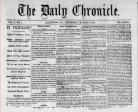Introduction to Oscar Wilde’s Reviewers
Created by vic peralta on Tue, 12/14/2021 - 21:07
My essay focuses on the histories and political views that shined through in their reviews of the St. James Gazette, Punch, and the Daily Chronicle.
Timeline
Chronological table
| Date | Event | Created by | Associated Places | |
|---|---|---|---|---|
| 20 Jun 1890 |
St. James Gazette Review Was PublishedThe St. James Gazette was a London evening newspaper published from 1880 to 1905, and it was founded out of the Pall Mall Gazette. The Pall Mall was—what we’d know as—radically right-winged, conservative, imperialism supporters, and extremely nationalist (Lee 165); their leadership was handed down to a few liberally left folk who intended to turn its image around to support liberalism, thus the St. James Gazette was born in order to keep their conservative views alive. The founder was Henry Hucks Gibbs (1819-1907), later to be named and ranked by his peers as Baron Aldenham, and he was a director of the Bank of England from 1853 to 1901 and its governor from 1875 to 1877. Aldenham was a huge part of the Conservative Party in Britain. The paper's first editor was Frederick Greenwood (1830-1909), who was the editor of the Pall Mall and had resigned immediately when the Pall Mall switched to liberal views. Greenwood stayed at the St. James Gazette until 1888, where he reigned and cemented their positions on nationalism; he was succeeded by Sidney Low (1857-1932), who was also conservative according to his obituary. It was during Low’s editorship on June 20th, 1890, when the St. James Gazette published their review on The Picture of Dorian Gray. This reviewer did not enjoy the book at all, going at lengths to discredit the novelist’s motives, accomplishments, grammar, syntax, aspirations, and comprehension. They even tapped into their homophobia, which is how many of the readers reacted as well. |
vic peralta | ||
| 30 Jun 1890 |
The Daily Chronicle's Review Was PublishedThe Daily Chronicle, now known as the Daily Mail. The Daily Chronicle was a daily British newspaper that published and functioned under that name from 1872-1930 until merger with Daily News; it ceased publication on 17 October 1960 as it was being absorbed into the Daily Mail. It was the best selling daily newspaper in Britain throughout the 1890s, when the review of Wilde’s novel was published. The Daily Chronicle wasn’t just sold in Britain though, but it was also widely circulated in the thirteen colonies. The Chronicle prided itself on being left of center politically and supported the radical wing of the Liberal Party. This was its position when it published its review on Wilde’s novel. The reviewer believes that anyone who comes in contact with the book will be tainted, but otherwise is “harmless padding,” meaning that the book was full of unnecessary material that was introduced to make it reach a desired length (Bell [11]). So, this review criticized Wilde’s talent, ability to write about the supernatural, and misunderstood the moral of the story. It was also slightly homophobic. This point of view and misunderstanding of the novel would go across Britain and its colonies. |
vic peralta | ||
| 9 Jul 1890 |
Punch's Review Was PublishedPunch, also known as the London Charivari, was an English illustrated weekly magazine published from 1841 to 1992 and 1996 to 2002. It was famous for its satirical humour and caricatures and cartoons. The first editors were Henry Mayhew (1812-1887), Mark Lemon (1809-1870), and Joseph Stirling Coyne (1803–1868). Mayhew was an English journalist and sociologist whose book, London Labour and the London Poor, influenced Charles Dickens, among other writers; he was known for being spot on in his reportage of people. Lemon was known for his plays, and he financially kept the magazine alive (because of these plays and because they took money to influence political opinions of caricatures) until it was popular and doing well. Coyne was remembered for his humor and puns and for his satire of Victorian social and artistic conventions. These editors were long gone from the magazine by the time they published a review along with their notoriously known illustration on The Picture of Dorian Gray. Since then, the magazine’s political affiliations were left and right, influenced by the Church, the government, not what we know today as lighter and cheeky. At the time of the review for Wilde’s novel, they were “conservative” and had enjoyed “stereotyping,” as it was its new “innovation to be reckoned with'' in the house. Along with their conservative views in 1890, Sir John Tienniel (1820—1914) was the illustrator for Punch at the time. Tienniel was an English illustrator and satirical artist best known for his illustrations in Alice’s Adventures in Wonderland (1865) and Through the Looking-Glass (1872). The literary editor of Punch at the time was Francis Cowley Burnand (1836-1917), who most thought wrote this review under the name of “Baron the Bookworm”. But in a July 26, 1890 letter to Henry Lucy (1845-1924), a staff writer at Punch, Wilde claimed to have uncovered the Baron's true identity; Lucy edited the letter to remove the name before publication. So, we don’t know who The Baron the Bookworm is, whom the reviewer refers to as themself in the review, as the person who writes it. Either way, it was said that Baron de Book-Worms “can make or mar the success of a new book,” similar to much more popular reviewers who influenced the public’s view in the literary world. Baron had concluded that this story could’ve been written better, was unclean in a homophobic and Biblical sense, Wilde was not a great writer, and that he wants to forget all about it. As said earlier, Baron influenced the success of this book, and with this kind of review, he definitely had discredited Wilde as a novelist. |
vic peralta |



